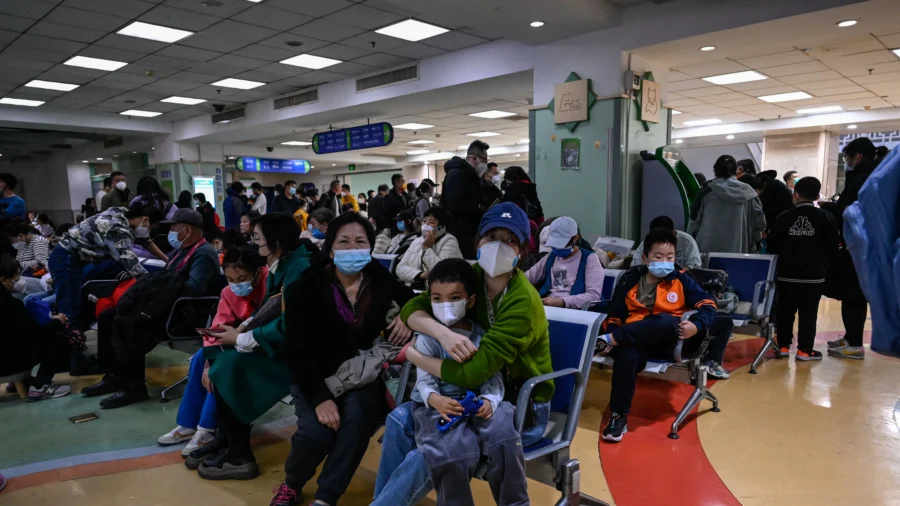China’s top health body urged hospitals nationwide to extend service hours and set up more clinics, as the recent increase in respiratory illnesses drew global concerns.
The message delivered at the Nov. 26 press conference held by the National Health Commission (NHC) came as domestic media reports showed long lines formed at pediatric hospitals, with some parents reporting that they waited up to eight hours to get their children to see a doctor.
Health officials on Sunday acknowledged that hospitals are overcrowded, and to quell public concerns, they urged local clinics to enhance their capacity to accommodate the growing number of patients.
“Efforts should be made to increase the number of relevant clinics and treatment areas, appropriately extend service hours, and strengthen guarantees of drug supplies,” NHC spokesperson Mi Feng told reporters on Sunday.
“It is necessary to do a good job in epidemic prevention and control in key crowded places such as schools, childcare institutions, and nursing homes, and to reduce the flow of people and visits.”
The health ministry reiterated the previous response to the World Health Organization (WHO), attributing the recent spike in acute respiratory cases to a combination of pathogens, most prominently influenza.
Wang Huaqing, the chief expert at the Chinese Center for Disease Control and Prevention’s (CDC) immunization program, listed other pathogens behind the rise in cases among the 5 to 14 age group, including the rhinovirus, a typical cause of the common cold, and mycoplasma pneumoniae, a bacterial infection that usually affects younger children.
The SARS-CoV-2, which causes COVID-19, is also being detected among patients aged over 60, according to Mr. Wang.
Health System Under Strain
Health officials did not provide data during Sunday’s press conference. Cases among children are notably prevalent in northern areas like Beijing and Liaoning Province, where hospitals are alerting the public about prolonged waiting times.
The surge in infections has placed a strain on the country’s health system. In Tianjin, medical staff at Tianjin Children’s Hospital’s outpatient and emergency departments reportedly handle 10,000 to 12,000 visits daily. At the same time, Hongqiao Hospital has summoned some retired pediatric doctors to return to work to deal with the surge in cases, according to a Nov. 18 report by Enorth, a local media outlet backed by the municipal government.
The regime’s claim that mycoplasma pneumoniae was behind the recent spike has already met with skepticism, with residents saying that they tested negative for mycoplasma.
“I suspect that this is not mycoplasma pneumonia because I have tried all kinds of drugs that are used to treat mycoplasma pneumonia, but none of them works,” Wang Hua (alias), a pediatric doctor in Beijing who was infected himself, told The Epoch Times earlier this month.
Some suspected that the country was grappling with the rebound in COVID-19 infections, as the infected showed similar symptoms such as cough, fatigue, or “white lung.” They suggested the Chinese Communist Party (CCP) directed its officials and media to attribute the outbreak to other pathogens, such as mycoplasma pneumonia, instead of the coronavirus, given the Party’s top leader has declared a victory in combating the pandemic.
CCP Conceals Data
At the core of the concerns was whether novel pathogens emerged in the recent illnesses. On Nov. 22, the WHO asked Beijing for detailed information, noting that the media and ProMed, a public health surveillance system run by the International Society for Infectious Diseases, reported clusters of undiagnosed pneumonia among children in China.
“A key purpose was to identify whether there have been ‘clusters of undiagnosed pneumonia’ in Beijing and Liaoning as referred to in media reports,” the WHO said in the statement.
On Nov. 23, the WHO said it received the clinical information, laboratory results, and other data it requested. The United Nations health body said the data shared by China’s health authorities suggested the spike in respiratory illnesses was linked to the regime’s retreat from the nearly three-year-old zero-COVID policy.
“Chinese authorities advised that there has been no detection of any unusual or novel pathogens or unusual clinical presentations,” according to the Nov. 23 statement.
The Chinese communist regime has borne the brunt of global scrutiny in reporting outbreaks since 2003, when health experts accused Beijing of covering up the Severe Acute Respiratory Syndrome (SARS) epidemic, a previously unknown virus believed to have emerged from the southern Guangdong Province before it spread into major Chinese cities and nearly 30 countries.
After another virulent respiratory disease appeared in central Wuhan city in late 2019, health experts and officials worldwide have repeatedly questioned the accuracy of the country’s data.
Earlier this year, as a massive wave of COVID-19 overwhelmed hospitals and funeral homes following the sudden lifting of pandemic restrictions, the WHO once again appealed for transparency, stating that China’s official tallies are underreporting the actual scale of the outbreak.
Reuters contributed to this report.
From The Epoch Times


